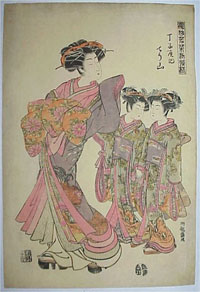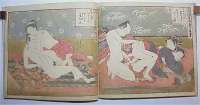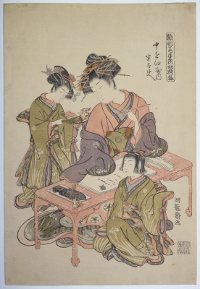Isoda KORYUSAI (1735-1790)

Click here to view image full size.
A chuban print showing two unidentified birds eating ripe pomegranites. Koryusai designed a considerable number of kacho prints in this chuban format. They are all rare. J. Hillier in his book A New Approach, G. Bell And Sons Ltd, 1960, p.74, states that “… kacho represent a sphere in which Koryusai is pre-eminent and in respect of which his genius has not been sufficiently acknowledged.” Published c 1770. Another (very faded) impression is in MFA Boston, 21.8240.
Very fine impression, colour and condition. Excessively rare in this fine, unfaded condition. Signed Koryusai ga.
Status: Sold
Isoda KORYUSAI (FL c 1764-1788)
Click here to view image full size.
A superb original painting, full colour on silk, showing a beauty running in a late snowfall. Cherry blossom above. A leading artist of his time who produced some of the best bijin and kacho prints of the 1770s before concentrating on painting. Image size 40.25 x 14.25 in; 102.5 x 36 cm. Good condition. Painted c 1778. Signed Koryusai ga with seal Masakatsu, no in.
Status: Sold
Isoda KORYUSAI (1735-1790)
Click here to view image full size.
An hashira-e showing nine cranes, a pine tree and the rising sun. A triple talisman of good luck. The tancho ( “red crest” ) Japanese Crane, Grus japonensis, is the second rarest crane in the world, migrating to East Asia in the fall to spend the winter. There is also a resident flock in Hokkaido. Much loved by the Japanese, the crane was a symbol of luck, longevity and fidelity. Rare: Another impression is illustrated in Jacob Pins, The Japanese Pillar Print, V & A, 1982, no. 518 ( which is also illustrated in the V & A Museum catalogue, The Floating World Japanese Popular Prints 1700-1900, 1973, no. IV8 ). Published c. 1770. Koryusai was probably the most prolific designer of pillar prints, although he designed few kacho-e. Ex collection Seisuke Ikeda, 11 -12th April, 1910.
Very good impression. Good colour. Slight fold marks ( as usual ) but generally good condition for a pillar print. Signed Koryusai ga.
Status: Sold

Click here to view image full size.
Isoda KORYUSAI (Fl. c 1764-1788)
Click here to view image full size.
A dragon emerging from a muddy mire. Presumably a depiction of the dragon brought forth by Chinnan to produce rain in the parched village of Sogo. Koryusai copied a drawing or painting by Ganki ( top right inscription reads: ‘Painted by Ganki’ ). Extremely rare. I cannot locate another impression at present.
Very good impression. Colour applied by hand: Sumi; green ( on fangs ); gofun ( on claws ). Sumi also scraped or brushed on to simulate sprayed mud. One or two repaired wormholes and signs of mounting au verso, otherwise very good condition. Signed Hokyo Koryusai sha ( ‘Copied by Koryusai’ ).
Status: Sold
Isoda KORYUSAI (fl. c 1764-1788)
Click here to view image full size.
A rare chuban showing a female monkey grooming a youngster, a waterfall behind. Saru, “Ape” from a set of “Twelve Elegant Signs [ of the Zodiac ] “. Koryusai produced some of the most exquisite kacho of the eighteenth century. Published c 1780.
Very good impression and colour. Minor soil, otherwise good condition. Signed Koryusai ga.
Status: Sold
Isoda KORYUSAI (c 1764-1788)
Click here to view image full size.
A chuban print showing the high-ranking courtesan Nanakoshi sitting beside a brazier reading a book. Her loose kimono has a design of fans (ogi – referring to her house, Ogi-ya). Koryusai was born a samurai in the service of the Lord of Tsuchiya but became an ukiyo-e artist producing many fine prints – especially kachoga – books and specialised in painting after c 1780. Three collectors’ seals: M. & C. Forrer and au verso McCabe and unread.
Fine impression and colour. Small thinned area, otherwise fine condition. Signed Koryusai dzu.
Status: Sold
Isoda KORYUSAI (1735-1790)

Click here to view image full size.
An hashira-e, “pillar print.” A night scene showing a beauty on the shoulders of her lover reaching up to a branch of plum blossom beneath a spring moon. From a set Furyu Rokkasen, “Fashionable Six Poetic Immortals,” this being a poem by Ariwara no Narihira (825-880) where the poet composes a poem inspired by a beauty he has seen. Koryusai was the master of this format. Pillar prints were introduced to hang, when mounted, on the pillars of a Japanese house. Consequently, they often come browned, creased or faded and finding good examples is difficult. Rare: Not in Pins.
Very good impression and colour. Slightly toned, otherwise very good condition. Signed Koryusai ga.
Status: Sold
Isoda KORYUSAI (1735-1790)

Click here to view image full size.
An oiran, Meizan (or Nayama) of the Chojiya House in the Shin-Yoshiwara with her two kamuro. From a large series – the total not known – with title: Hinagata wakana no hatsu moyo, “New Designs as Fresh as Young Leaves.” Published in the late 1770s by Eijudo with some designs by Juzaburo. A wonderful set. Another impression in MFA, 11.14622.
Fine impression. Exceptionally good colour. Very slight thinning down two sides, otherwise fine condition. Signed Koryu ga with printed kakihan.
Status: Sold
Isoda KORYUSAI (1735-1790)
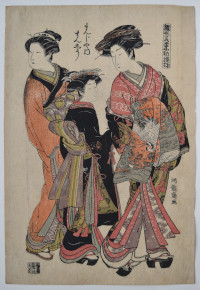
Click here to view image full size.
Manjiya uchi Manshiu, “Manshiu of the Manjiya [Brothel or House]” from a set: Hinagata wakana no hatsu moyo, “New Year Designs as Fresh as Young Leaves.” One of the great 18th century sets comprising at least 140 prints of consistent quality throughout. Shows the oiran with her two kamuro. Published in the late 1770s by Eijudo with some designs by Juzaburo.
Fine impression and colour. Slight creasing, otherwise very good condition. On heavy hosho. Signed Koryusai ga.
Status: Sold
Isoda KORYUSAI (1735-1790)

Click here to view image full size.
A hashira-e, “pillar print” showing two women washing clothes at a well. Koryusai cleverly uses the ropes of the pulley to emphasize the narrow format. Koryusai was the master of this sort of print. Pillar prints were introduced to hang, when mounted, on the pillars of a Japanese house. Consequently, they often come browned, creased or faded and finding good examples is difficult. Rare: Other examples in MFA Boston, acc. no. 21.8379 (ex Metzgar sale 1/12/1921); TNM, catalogue 1, (1960), no. 742; and illustrated in Pins, The Japanese Pillar Print, 1982, no. 396.
Very good impression. Good colour. Slight toning and small repair bottom right corner, but otherwise a nice example. Signed Koryusai ga.
Status: Sold
Isoda KORYUSAI (Fl.c.1764-1788)
Click here to view image full size.
The courtesan Chozan of Choji-ya from the series: Hinagata Wakana no hatsu-moyo, “Models for Fashions: New Designs as Fresh as Young Leaves”. The set published c.1782. Printed on heavy hosho.
Fine impression. Exceptional colour for a print of this series and date. Expert edge repair at centre left and slight signs of mounting au verso around edge, but otherwise a fine example. Signed Koryusai ga.
Status: Sold
Isoda KORYUSAI (1735-1790)
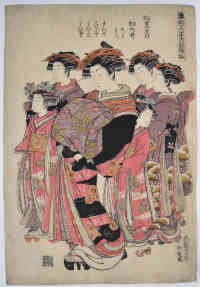
Click here to view image full size.
The courtesan Matsunoi of the Matsubaya with her kamuro. From a large series Hinagata wakana no hatsu moyo, “Models for Fashion: New Year Designs as Fresh as Young Leaves.” Published by Eijudo and Juzaburo in the late 1770s. This set is the largest known bijin series (140 prints being known). However, the quality is consistent throughout. One of the great sets.
Fine impression with excellent colour. Minor soil, otherwise very good condition. Signed Buko Yagenbori inshi, Koryu ga.
Status: Sold
Isoda KORYUSAI (1735-1790)

Click here to view image full size.
A pillar print, hashira-e, of a beauty after a bath cooling herself with a fan. A cat looks up adoringly from below. Above her is a temple bell wind chime, often hung in the summer. Masanobu laid claim to have invented the pillar print format. Roger Keyes has suggested that, because many large format prints from the 1740s were printed using two blocks of wood, there was a tendency for the blocks to separate during use, giving rise to the hashira-e shape. Probably the most interesting format in that the restrictions often led to creative compositions. And figures sometimes partially exit or enter from the side, giving weight to the theory of separating blocks of wood. Certainly, these prints were hung on pillars in houses, and because of this they often come browned, faded or damaged. Koryusai was the artist par excellence when it comes to pillar prints. Rare.
Very good impression and colour. Slight toning, but in very good condition for such a print. Signed Koryusai ga.
Status: Sold
Isoda KORYUSAI (fl.c.1764-1788)
Click here to view image full size.
Two complete koban sets of twelve prints each showing loving couples. Two double pages shown from each album.
Minor soil and one stain, but otherwise very good impression, colour and condition.
Status: Sold
Isoda KORYUSAI (Active c 1764-1788)
Click here to view image full size.
The courtesan Handayu of Naka-Omiya seated at a writing desk attended by two accolytes. From a superb, large series: Hinagata wakanano hatsu moyo, “Models for Fashion: New Year Designs as Fresh as Young Leaves.” Published by Nishimura Eijudo, c 1776-7. Yoshida catalogues this set in Ukiyo-e, no. 26. A beautiful deluxe print.
Superb impression on thick hosho. Very slight fading of red and expertly repaired binding holes near left edge, otherwise very good condition. Koryusai ga.
Status: Sold
Isoda KORYUSAI (Fl. c 1764–1788)
Click here to view image full size.
A chuban print entitled Yu, “Evening,” showing the courtesan Matsushita of Matsubaya with two acolytes. Koryusai was an ex samurai. Well known for excellent and rare kacho and some fine hashira-e. Published c early 1770s. Ex collection Paul-Louis de la Noe, 1879-1919, ( an acquaintance of the Goncourt brothers, Bing and Hayashi ). Rare.
Fine impression. Fine well retained fugitive pigments. Slight soil at bottom, otherwise very good condition. Signed Koryu ga.
Status: Sold








